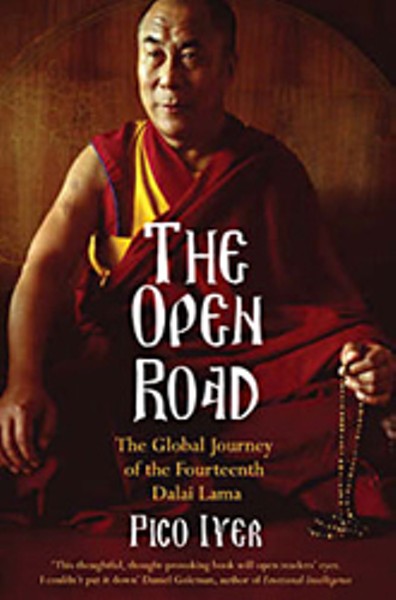By Pico Iyer.
Knopf.
At the center of today's conflicts and aspirations, the Dalai Lama stands as an embodiment in proxy for his stolen and decimated nation (China began to invade in 1949), but also an example of nonviolence and reconciliation. From humble village origins to a state of virtual divine rule as a child, through war and genocide, into exile, he has moved onto a global stage as a pragmatic political warrior rather than a refugee. Seen by some as a living Buddha, and yet by others as simplistic in his views and approaches either too forgiving and peaceable to effect true political change, or else too holy to be taken seriously the leader of Tibet-in-exile is an enigma perfectly suited for author Pico Iyer's talents of equivocal observation and outside-the-box analysis. His presence brings up the difficulties of incarnation of the divine, but also the ironies of human expectation. Though he can't please everyone he advocates reconciliation with China rather than a surely justifiable Tibetan revolution, for example the Dalai Lama walks deftly the tightrope of "spiritual celebrity." He holds the equivalent of a rigorous Ph.D., but speaks simply so that even a child can understand.
Pico Iyer, via Santa Barbara and Oxford, and of East Indian parentage, has been on the beat of global irony for three decades, searching with wit and sympathy for the culture emerging from incongruous meetings and unexpected appropriations. The title alone of his earlier book, Video Night in Kathmandu,suggests no cultural region can exist separately, without infection or inspiration from all others. Though Hollywood and Bollywood seem culturally dominant, an equal influence from traditional sources pushes back. A peripatetic travel essayist, Iyer seeks those nexus regions where, despite seemingly "falling off the map," the world works out the complications of the "Global Soul." What are self, home and spirit in the face of seeming mono-cultural and technological developments?
Iyer's father, the Oxford/UCSB professor Raghavan Iyer, went to meet the young Tenzing Gyatso in 1960, shortly after the Lama had been forced to flee to Dharamsala, India, where Tibet's exile government is based. He brought back for the young Pico a devotional picture of the Dalai Lama, which came to symbolize a far-away and exotic land, and also the Gandhian political and spiritual engagement his father studied. When that photo and all he owned were burned in a wildfire that consumed his family's Santa Barbara mountain home, Pico Iyer was thrown into an exile parallel to that of the Tibetan. Living in Japan, but also experimentally in airports, he's regularly on the open road with the Dalai Lama and allowed close personal access to the man, not just the leader or guru.
Being a non-Buddhist agnostic, yet son of a man who was regarded as Teacher and an embodiment of Krishna by his followers in the S.B. Lodge of Theosophists (the Dalai Lama once spoke in their little hall), Iyer's views are particularly convoluted, personal and revealing. He neither believes nor disbelieves. This reviewer, once a member of that Theosophy group (founded by Iyer's parents), recalls one night where Pico Iyer spoke on esoteric themes. It was said that he'd off-handedly called us "dopey-gopis," after the erotically Krishna-obsessed milkmaids of ancient lore. A telling remark, especially in light of the Dalai Lama's recommendations to not follow him, nor become a Buddhist per se, but rather to seek to live a larger, better, more compassionate life, within one's own traditions. Iyer's book, lucidly involved and yet complexly skeptical, is a window into the shared admixture, possibility and conflict in our negotiated and embattled present.


Comments (7)
Showing 1-7 of 7